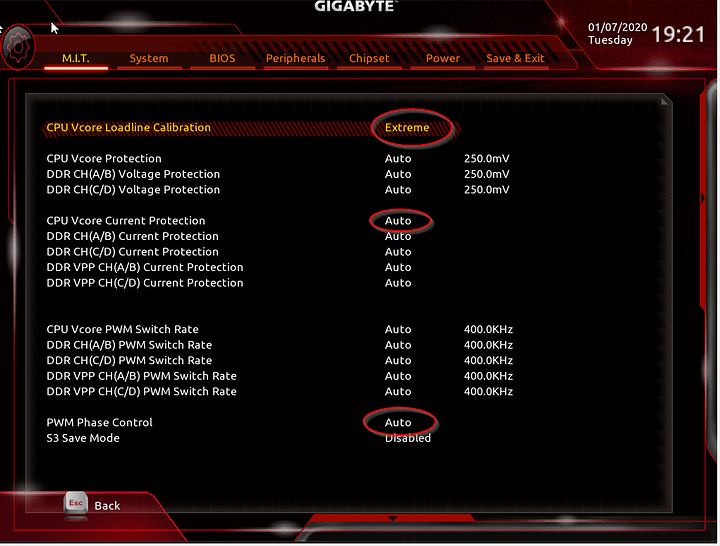As a new owner of a Gigabyte X299 Gaming 7 Pro… I’m not happy some pretty important overclocking features were omitted on a board with a superior VRM: OCP, OVP and PWM Switching Frequency are all absent!
In fact, reviewing product manuals, the only boards that has these features for sub zero OC to even function with a 18 core is the Aorus Gaming 9 and the entire X299X series. The X299 Aorus Master is left out here, and so is my board.
The official X299 OC thread on the Gigabyte forum also incorrectly mentions this:
these setting are valid for all AORUS gaming motherboards series
…except the screenshot you got was from a Aorus Gaming 9. In reality, the X299 Aorus Master and the Gaming 7 Pro, plus the entire legacy Gaming 7 and below boards don’t have OVP, OCP and PWM Switching Frequency…
The above image is impossible on anything other than the Aorus Gaming 9 and the X299X boards. The big point is this is the official Gigabyte OC thread that doesn’t know that these features are missing:
https://forum.gigabyte.us/post/38864
You also cannot change the PWM switching frequency or do PWM Phase Control (but that might be less important) on all X299X boards. All you can do is OVP, OCP and LLC the VRIN.
This is from the X299X Designare 10G:
(from a “Just Buy It!” review. But Wendell had the same board for a while and could confirm if the menu is as barebones as this)
Where would an oversight like this be tolerable?
The X299 Designare EX, the X299-WU8 and the original Gaming 7 (non-pro) would be good candidates for the “tolerable” category, because you don’t need extreme OC features on workstation boards, and the original Gaming 7 had the higher tier you could purchase at that time because the VRMs were identical. The X299X Designare 10G, a workstation board of the refresh gen, didn’t have this problem to as bad of an extent (Switching frequency is still missing) and Buildzoid even overclocked on said board.
Where it’s acceptable to be missing is anything the Gaming 3, Ultra Gaming, and UD4 and below.
Where it’s unacceptable is the X299 Aorus Master and the X299 Aorus Gaming 7 Pro. These are good candidates for competitive overclocking and to have an oversight like this instantly gives you buyer’s remorse if critical features are left out. These boards lack the extra options in “Advanced Power Options”. (and they have superior VRMs to the Gaming 9, what was considered highest tier by Gigabyte at the time.)
Unfortunately, Hardcore OC VFIO users are in a rock and a hard place because if you feel like sub zero dry ice in your spare time, but also like to do some VFIO… Gigabyte is your only option because ASUS doesn’t allow you to select your boot GPU slot, nor does EVGA with their X299 Dark.
The Gaming 7 Pro also has what Buildzoid called the ideal PCI-E layout. Unfortunately this VRM feature omission makes it pretty tough to buy for anything other than a 10 or 12 core. Anyone that got a X299 Aorus Master should also be pretty miffed a high end board lacks OC controls that help in sub zero OC…
XOC BUYER BEWARE. The X299 Aorus Master may have good componentry, but is hampered by it’s BIOS for overclocking. The same goes with the X299 Gaming 7 Pro. The X299 Designare EX is excusable because it’s a workstation board and not a OC board, and so is the X299-WU8. Anything below with the Gaming 3, expect the feature to be missing, and once again the original Gaming 7 is tolerable with this setting removed because they had the same VRM but with the features in the Gaming 9, which you could purchase during the time the original Gaming 7 was out…
The Aorus Gaming 9 is akin to the Sony PXW-Z100. This 4K single sensor camera has a MONSTER recording setup capable of 4K 60fps All Intra 4:2:2 10 bit to XQD cards, but they used the same 1/2.3’’ sensor from a Sony Xperia phone, meaning the chromatic abrasion and usual grain and small sensor issues are amplified. The Gaming 9 has the best featured BIOS out of all of Gigabyte’s X299 lineup, but features a mediocre heatsink and mediocre 8 phase VRM which might have issues with 18 core CPUs once it hits high amperages. The ones with higher phase counts or better VRMs all lack one or more of the Gaming 9’s features. This is honestly baffling. When it comes to XOC, you need the full compliment of features.
The X299 Aorus Master is a trap for XOC, and the X299 Gaming 7 Pro has a chance to trip OCP if you do sub zero a 18 core. This mistake should not be buried or be forgotten. Had I known I would have tried for the X299X Aorus Master and rethought my PCI-E slot assignments, though this would NOT bring back the PWM switching frequency controls.
Unfortunately, my PCI-E slot assignments without purchasing newer M.2 risers worked better with the Gaming 7 Pro, so I basically have to tune my all core and turbo ratios instead of for super high clocks, for staying within the Turbo Boost 3.0 clocks. This is so dull by Buildzoid standards.

